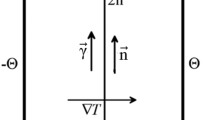Abstract
The three-dimensional unsteady thermal convection developing in a cubic cavity on board the “Mir” station under the action of the quasistatic component of the microacceleration caused by the earth’s gravity field strength gradient and the motion of the station about the centre of mass is investigated numerically. The calculations are carried out for two real time intervals of motion of the station about the centre of mass using actual values of the quasistatic component.
Similar content being viewed by others
References
V. I. Polezhaev, “Microacceleration regimes, gravitational sensitivity and methods of analyzing technological experiments in microgravity,”Izv. Ros. Akad. Nauk, Mekh. Zhidk. Gaza, No. 5, 22 (1994).
V. S. Yuferev, Yu. A. Polovko, A. I. Zhmakin, and E. N. Kolesnikova, “Effect of spacecraft rotation on convection and impurity transport under microgravity,” in:Proc. Joint 10th Europ. and 6th Russian Symp. on Phys. Sci. in Microgravity, St. Petersburg, Russia, 1997, Vol. I, Inst. Probl. Mech. RAS, Moscow (1997), P. 37.
V. S. Yuferev, E. N. Kolesnikova, Yu. A. Polovko, and A. I. Zhmakin, “Effect of the Coriolis force on thermal convection under microgravity,”Theor. and Comput. Fluid Dynamics,12, 53 (1998).
Yu. A. Polovko and V. S. Yuferev, “Effect of variations of the angular velocity of spacecraft rotation on thermal convection in microgravity,”Pis’ma v Zh. Tekh. Fiz.,23, No. 24, 6 (1997).
V. S. Yuferev, Yu. A. Polovko, and V. V. Sazonov, “Three-dimensional thermal convection caused by spacecraft rotation in a rectangular enclosure with rigid walls,”Phys. Fluids,10, 10, 2517 (1998).
V. V. Sazonov, M. M. Komarov, V. I. Polezhaev et al., “Microaccelerations on board the Mir orbital station and quick analysis of the gravitational sensitivity of convective heat/mass transfer processes,” in:Proc. Joint 10th Europ. and 6th Russian Symp. on Phys. Sci. in Microgravity, St. Petersburg, Russia, 1997, Vol. 2, Inst. Probl. Mech. RAS, Moscow (1997), P. 284.
St. Boschert, A. N. Danilewsky, and K. W. Benz, “Numerical simulation of the influence of the orbiter’s altitude on the µg growth of InP:S crystals from an In solution during the EURECA-1 flight,”J. Crystal Growth,205, 92 (1999).
V. V. Sazonov, M. M. Komarov, M. Yu. Belyaev et al., “Estimate of microaccelerations on board the “Mir” orbital station on the basis of the readings of an optical star probe,”Kosmich. Issled.,34, 491 (1996).
Additional information
Moscow, Sankt-Peterburg. Translated from Izvestiya Rossiiskoi Akademii Nauk, Mekhanika Zhidkosti i Gaza, No. 3, pp. 39–45, May–June, 2000.
Rights and permissions
About this article
Cite this article
Sazonov, V.V., Yuferev, V.S. Thermal convection initiated by the quasistatic component of the microacceleration field on the “Mir” orbital station. Fluid Dyn 35, 346–350 (2000). https://doi.org/10.1007/BF02697747
Received:
Issue Date:
DOI: https://doi.org/10.1007/BF02697747




